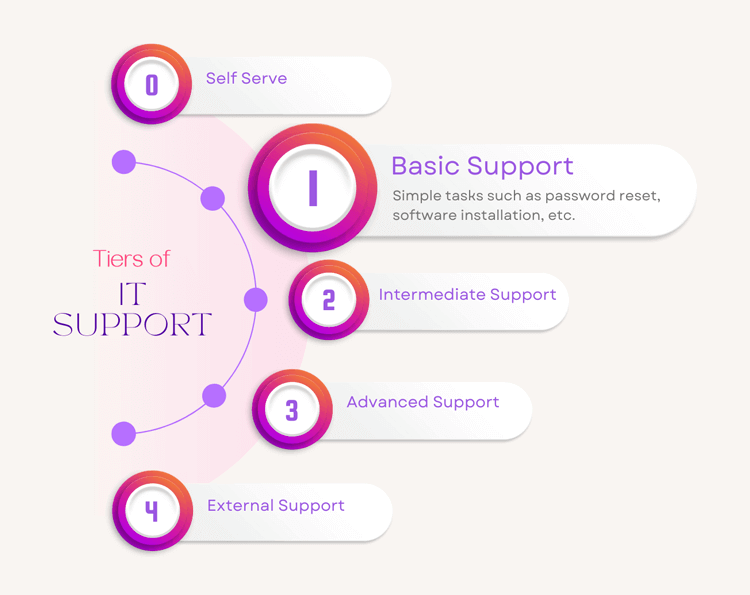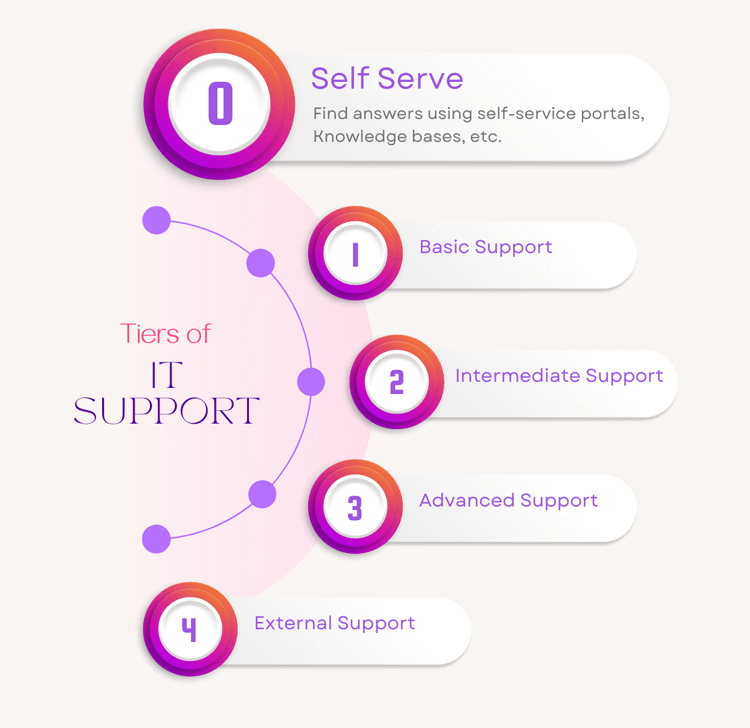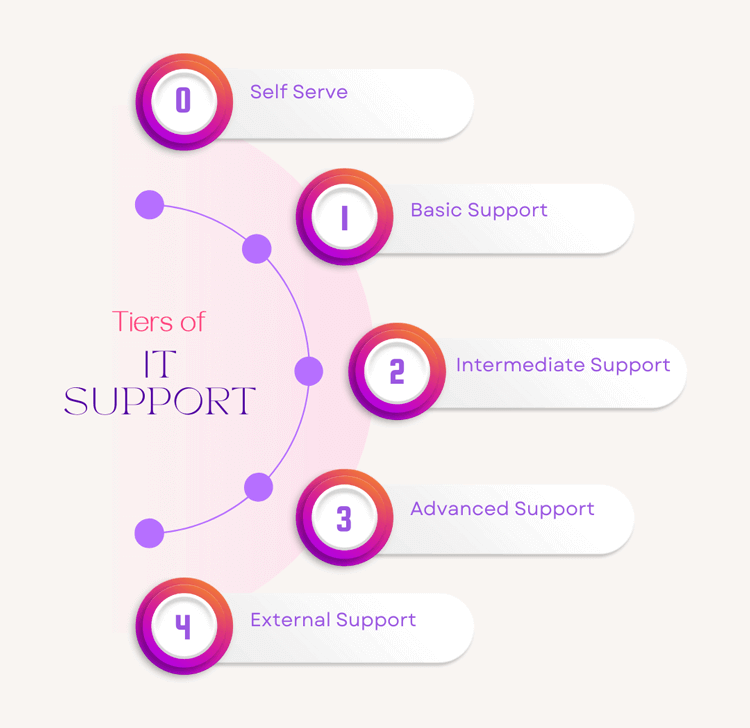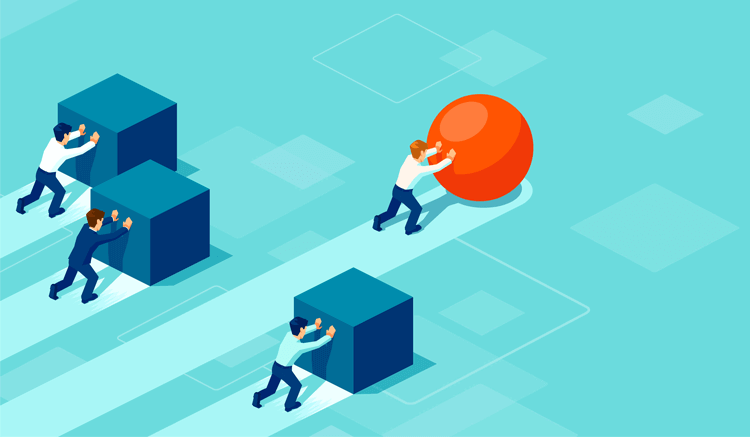Tier 1 IT Support Fully Explained: Level 1 Help Desk
Tier 1, also known as Level 1, or the help desk tier, is the front-line of human agent support in an IT support organization.
Tier/Level 1 handles basic technical issues and service requests that are beyond the scope of self-service solutions (Tier 0). Tier 1 help desk support typically involves answering user inquiries, resolving straightforward issues, and managing service requests through several communication channels such as Live Chat, support tickets, email, phone, and sometimes, in-person.

TL;DR
- Almost everyone who uses software, email, and devices in the workplace encounters problems at one time or another.
- When self-serve IT portals, also known as Tier 0, don't provide an answer, people need to turn to IT agents, and the first point of contact is the Tier 1 agent.
- Accessing ITIL user support, usually by submitting a support ticket via help desk software, will always go through to Tier 1 agents, unless an automated system automatically routes it to a higher tier due to the level of complexity.
Read on for details...
What is Tier 1 IT Support (Level 1)?
Tier 1 IT Support, often referred to as Level 1 IT Support, is the front line of IT service management (ITSM). Whether delivered by an organization's IT department or a third-party IT customer service team/vendor, Tier 1 is critical for resolving issues quickly while safeguarding higher-level resources for more complex issues.
Tier 1 is designed to troubleshoot common IT problems like password resets, software installations, and basic network connectivity issues.
This tier helps maintain a positive user experience by providing prompt, effective responses to common issues, reducing downtime, and improving user satisfaction.
Tier 1 support also plays a key role in gathering initial information about an incident. This can be crucial for quicker resolution for tiers 2 and above.
Why Does Tier 1 IT Support (Level 1) Play a Critical Role in ITSM and Help Desks?
Tier 1 is an integral part of any ITSM framework that improves user satisfaction through the delivery of quick IT solutions. The intention is to keep downtime to a minimum.
As ITSM organizations continue to support digital transformation strategies, the amount of IT support has increased for every company. When Tier 1 handles routine support requests, it serves as a filter. This helps make sure that only more complex and specialized issues reach higher support levels.
When ITSM teams and ITIL operators keep the resolution of simple troubleshooting tasks to Tier 1, help desk teams can reduce operational costs, and improve overall service levels and customer service scores (e.g., CSAT, NPS, etc.). Especially when users try and successfully solve their own problems using Tier 0 (self-serve) resources.
Pros and Cons of ITSM Tier 1 IT Support
With five tiers of IT support, from self-serve to the most advanced technical support, your organization will benefit from having all five tiers to support your staff. Here are the pros and cons of Tier 1 support.
Pros of Tier 1 IT Support
- Improved Response Times: With Tier 1 handling routine issues, users receive quicker support. This helps to reduce downtime and improve organizational productivity.
- Cost-Effective: When common problems are handled at a lower-cost tier, organizations can optimize their IT resources and reduce overall support costs.
- User-Friendly: Tier 1 provides a human touch, which can be more reassuring for users who may not be comfortable with self-serve portals and AI chatbots.
- Efficient Issue Escalation: Tier 1 support serves as a gatekeeper, ensuring that only complex problems are escalated. This can streamline the workflow for Tier 2 and Tier 3 teams.
- Knowledge Base Development: Data collected from Tier 1 interactions can be used to improve self-service resources, reducing future help desk ticket volumes.
Cons of Tier 1 IT Support
- Limited Expertise: Tier 1 support staff usually only have general IT knowledge. This may not be sufficient for more complex issues, leading to frequent escalations. If they're not well trained or are only following troubleshooting scripts then that will also cause problems.
- High Turnover Rates: The repetitive nature of Tier 1 support roles can result in high staff turnover. Plus, Tier 1 is often overworked, and this can disrupt service continuity and increase training costs.
- User Frustration: Users with more complex issues may become frustrated if they have to go through Tier 1 before reaching the appropriate level of support. It's better to ensure an AI-powered ticketing system routes an issue to the right level of support automatically.
- Poor Resource Allocation: Relying heavily on Tier 1 can lead to underutilization of higher-skilled technicians in Tier 2 and beyond.
- Potential for Overload: If Tier 1 is not properly staffed or if there is a surge in support requests, it can lead to long wait times and a backlog of unresolved issues. Make the most of self-serve to reduce the risk of this happening.
How to Set Up Tier 1 IT Support: 5 Stages for an IT Help Desk
Setting up an effective Tier 1 IT Support team involves several critical steps:
- Define the Scope of Tier 1: Clearly define the types of issues that Tier 1 will handle. This typically includes basic troubleshooting, password resets, and common user inquiries. Establish clear guidelines for when issues should be escalated to higher tiers.
- Recruit and Train Staff Well: Hire staff with strong communication skills and a solid foundational understanding of IT concepts. Provide comprehensive training on the specific systems, software, and processes used in your organization. This ensures that Tier 1 technicians can handle the most common issues effectively.
- Implement a Robust Ticketing System: Deploy an AI-based ticketing system that enables efficient tracking, prioritization, and resolution of support requests. The system should allow Tier 1 technicians to log details, categorize issues, and escalate tickets as needed.
- Develop a Knowledge Base and Resources: Create a centralized knowledge base that Tier 1 technicians can use for troubleshooting common issues. This resource should be continually updated based on feedback and new issues encountered.
- Monitor Performance and Provide Continuous Feedback: Regularly review the performance of your Tier 1 support team through SLA-based metrics like ticket resolution times, user satisfaction, and escalation rates. Use this data to provide ongoing training and make process improvements.
How Does Tier 1 Compare to Other ITSM Support Tiers?
For more information on every tier of IT support, here are our 5 Tiers of IT Support Explained: Tier 0 to Tier 4, ultimate guide.
Tier 1 vs Tier 0
Tier 0 is the self-service solution, while Tier 1 involves a front-line IT team for basic troubleshooting and issue resolution.
Tier 1 ITSM staff handle issues that cannot be resolved through Tier 0 resources. The aim of Tier 1 is to provide an issue resolution when a user cannot solve the problem themselves.
For more information on Tier 0 support, here's our article on Tier 0 (Level 0) IT Support.
Tier 1 vs Tier 2
Tier 2 support is for more complex issues that require deeper technical knowledge and expertise.
While Tier 1 handles simpler troubleshooting, Tier 2 IT staff handle and solve problems that require more in-depth and specialized knowledge. Technical issues at this level will probably take longer to resolve, so KPIs are usually adjusted the higher up an issue goes.
For more information on Tier 2 support, here's our article on Tier 2 (Level 2) IT Support.
Tier 1 vs Tier 3
Tier 3 is typically reserved for issues that require much higher levels of technical skills, such as bug fixes, platform knowledge (e.g., AWS, Google, Microsoft, Intel, etc.), and more complex system integrations.
While Tier 1 helps to solve basic problems, Tier 3 involves dealing with complex technical challenges.
At this level, IT staff are usually more senior and involved in strategic decisions and implementations. For example, digital transformation, platform migrations, and in-house software development often fall within the responsibilities of IT team members at this level.
For more information on Tier 3 support, here's our article on Tier 3 (Level 3) IT Support.
Tier 1 vs Tier 4
Tier 4 often involves working with external vendors and consultants who attempt to solve issues beyond the capabilities of an in-house team, or even a contracted ITSM vendor.
For more information on Tier 4 support, here's our article on Tier 4 (Level 4) IT Support.
How Do Different Tiers of IT Support Work Together to Make a Functional ITSM Team?
Different tiers of IT support need to work together to create a seamless, efficient IT support system. The larger the organization, the more IT support is required. Some companies have a hybrid of an in-house team while working with an external vendor.
The different tiers of IT support work together by handling issues with the appropriate level of expertise. This ensures that users receive timely and effective resolutions.
Tier 0 empowers users to solve simple problems themselves, while Tier 1 provides the first line of human support for more straightforward issues.
Complex issues are escalated to Tier 2 and Tier 3, where more specialized knowledge is applied. Tier 4 offers an external layer of support for highly specialized or vendor-specific problems.
This efficient tiered approach optimizes resource use, ensures efficient problem resolution, and aims to keep achieving all targets and KPIs set, including SLA adherence, and customer satisfaction scores.
Key Takeaways: Why Your Organization Needs Tier 1 IT Support
Tier 1 IT Support is essential for ensuring that users receive quick, effective assistance with their IT issues. In turn, this makes a massive difference in productivity, keeping downtime to a minimum.
If someone can't find a self-serve solution after a few minutes, that's going to impact productivity. So, that's where Tier 1 plays such a critical role.
Tier 1 also plays a crucial role in filtering and escalating issues, allowing higher-tier support teams to focus on more complex problems.
Implementing a well-structured Tier 1 support system (provided you have self-serve set up) will reduce costs, improve KPI performance, and ensure the overall efficiency of your ITSM organization.
Giva Can Help Your Tier 1 IT Support
Giva's help desk and ITSM software bring you real-time, highly-customizable dashboards with a large widget library. You'll be up and running in days, and your IT help desk and service desk teams can be trained in hours on our intuitive and friendly interface.
Other Giva features include:
- Harness the power of Giva's AI Copilot to effortlessly refine responses and quickly access and format solution information
- Automatically convert emails into tickets to streamline the ticketing process
- Customize Giva for any department or subsidiary organization and deliver real-time agent and team analytics to help improve performance
- Automatically open tickets on a scheduled and recurring basis
- Automate escalation and closure of tickets
To learn more, book a free Giva demo to see our solutions in action, or start your own free, 30-day trial today!





